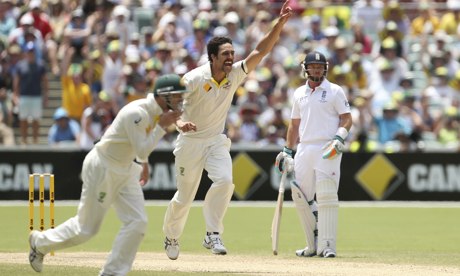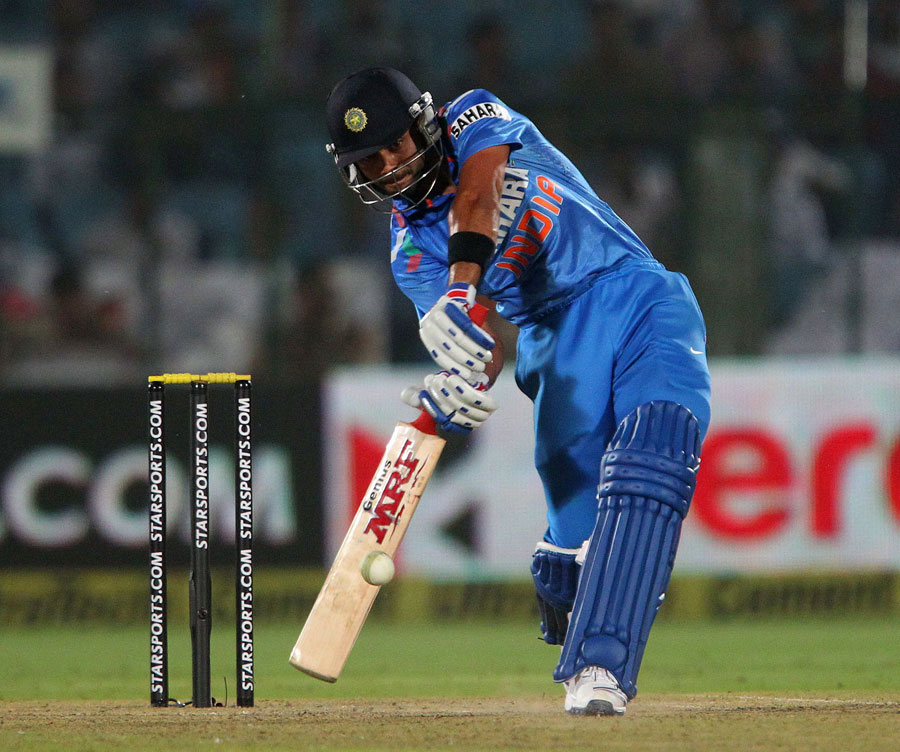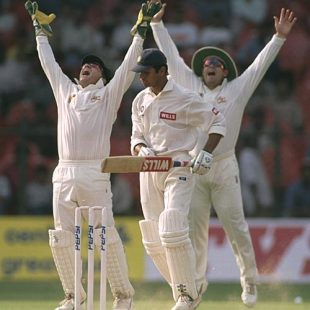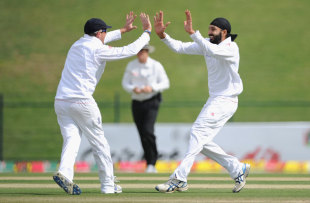Osman Samiuddin in Cricinfo
A decade ago cricket's ancient and embedded hyper-morality crashed into the modern world's burgeoning thirst for reality television. The focus for this communion was Muttiah Muralitharan, and more specifically his action. Two TV networks, ESPN (in India) and the UK's Channel 4, broadcast what were paraded at the time as definitive acquittals of Muralitharan's action, which had till then been called periodically, sanctioned occasionally, and the subject of hysterical debate permanently.
------ALSO READ
------
Muralitharan went through his repertoire of deliveries with a steel-embedded plaster brace around his right arm, from bicep to wrist, and with admirable good nature. He looked a little uneasy in the ESPN show, a little too much like the guinea pig just becoming aware of his centrality to bigger, buffeting winds. But he went about it like a man who felt he needed to.
He bowled to Michael Slater in that one, to recreate match conditions. There was a doctor present too, explaining the unique physical quirks of Muralitharan's wrist, arm and shoulder, though he felt a little like Dr Nick Riviera, whose only residency of note has been on The Simpsons. Ravi Shastri, for ESPN, was quadruply burdened, as host, judge, jury and, eventually, the benefactor who cleared Murali. Shastri did so in the manner with which we are all familiar, effectively hype-mastering a science documentary. For Channel 4, Mark Nicholas managed a sombre posture, considered and inquiring but above all providing a kind of bipartisan seal on matters.
The issue by then had become so divided along racial lines that a non-Asian clearing of Murali felt necessary. That was the ultimate takeaway, of course, that Murali did not chuck. He could not with that steel brace on. Even Slats, an Aussie, said so.
In hindsight it is not so much the details of Murali's case that were important as was the fact that cricket felt the need for this public trial by TV in the first place. Even today, viewing it produces the kind of cringe only a certain kind of reality show does; especially the eagerness with which Muralitharan is cleared, as if he was guilty of some crime.
Though he looks uncomfortable in the ESPN version, Murali looked cheery and eager for Channel 4. He was probably a willing participant, perhaps even an instigator in doing the shows, but that is hardly the point. He was compelled into it by cricket, feeling no other recourse was available to prove that he was not some evil, cheating villain who would leave cricket forever corrupted. That is precisely what umpires such as Ross Emerson and Darrell Hair seemed to think he was, no-balling him with such ugly fervour that it was impossible to avoid feeling a vicarious humiliation at what Murali underwent. Men are prone to delusions when invested with the tiniest bit of authority in any case, but when furnished with a haloed moral authority they become monsters, or cricket umpires.
Hair and Emerson were after all only maintaining professional tradition. In every purge of suspect actions, umpires have led the hounding, right at the front of bloodthirsty crowds. Chuckers (and even the word is so phonetically derisive) have never been just men with kinks in their actions, or have seemed to bowl thus as a natural outcome of the overarm bowling action, which basically predetermines some degree of straightening (as an ICC survey discovered back in 2004). Cricket has treated chuckers as lepers because cricket doesn't have a reliable sense of a scale of bad: it can summon about the same amount of moral outrage for slow over rates as it can for Mankading, intimidatory bowling and match-fixing. It has a spirit nobody can define but one everybody screeches about when it is - regularly and easily - breached. So Murali and Saeed Ajmal walk around with an asterisk floating above them. To their detractors they are asylum seekers who exist only because of the weak-kneed liberalism of a governing body.
Maybe now the urge to purge is suppressed a little but the moralising over suspect actions remains; in the smugness of Australia and England that their offspinners do not bowl doosras, or feel the need to wear long sleeves (Shane Warne, one failed drug test plus one corruption scandal to the good, sniggering at Ajmal's long sleeves in the World T20 is a classic example of cricket's wonky moral scale); in Michael Vaughan tweeting and Stuart Broad responding to a photo of Ajmal in action and, metaphorically, nodding and winking. That yanks into black-and-white territory what is an inherently grey matter.
Suspect actions can be deliberate but they can also be functions of the mechanics of human bodies we do not understand. Could anyone have imagined that a study would find 99% of bowlers in cricket straighten their arm to some degree? What effects do injuries have, as a fairly serious accident did on Ajmal's right forearm when he was younger? How to explain the squirmy spectacle of Shoaib Akhtar being able to bend his elbow in ways that normally ought not to have been possible?
Where, in any case, is the study that sheds light on the exact nature of the advantages gained from greater elbow straightening? It is said that bowling the doosra is impossible without breaking the acceptable degrees of flex, but how to explain Saqlain Mushtaq, the pioneer, who did it with almost no visible bend at all? He even bowled it under the eyes of Hair and Emerson and elicited not a squeak, so he must have been fine, right? Even if we make the crazy assumption that post-Murali, Hair might have been chastened?
| Where is the study that sheds light on the exact nature of the advantages gained from greater elbow straightening? | |||
****
Cricket cannot continue being blind to the grey of this issue because soon we might be in greyer territory. Last week the ICC's cricket committee expressed its concerns about the identifying, reporting and testing of suspect actions. The processes, they said, need to change.
The primary reason appears to be discontent with the testing labs at the University of Western Australia in Perth, where bowling actions have hitherto undergone testing. The time and cost of sending a bowler that far has always been problematic but now more issues have emerged. One official familiar with the meeting last week says that there was concern about discrepancies in the findings of the Perth labs and others around the world. Apparently the Perth lab has not been following the exact protocols for testing actions that the ICC has laid down, disagreeing with the nature of those protocols.
So the ICC wants to accredit other labs around the world, in England, South Africa and India initially, and ultimately standardise testing protocols and results. The utopian aim is to have testing centres in every Full Member country, so that bowlers can be observed, tested and corrected at domestic level before they get further.
More significantly, they are also testing body sensors that could capture real-time analysis of a bowler's action during a game. These were tested by under-19 players at the recent World Cup but only in net practice, and much more work needs to be done before it goes further. The calibration of the sensors on the arm is a particular issue, especially after players dive in the field.
In time, that will be the least of the problems, because trickier questions will arise. Who will wear sensors in a game? Those who have already undergone testing once? Others we suspect have a kink in their action? Nobody, as the ICC says, is cleared permanently, so everyone is under the scanner theoretically. Singling out someone who may have a kink but has not been tested officially places an undue burden on the bowler and recreates, in a way, the TV trial Murali underwent. How real is real-time? Will we be able to see the results after each ball, after each over, after each session, after each day?
Mike Hesson has already asked how those with suspect actions will be policed: what happens, he said, if a wicket falls off a ball delivered by an action in breach of the laws? Will a TV umpire review it immediately? Umpiring technology hardly needs further complication. As it stands, these discussions haven't begun but these are difficult and complicated questions. It is, after all, a difficult and complicated issue, even if it feels sometimes that cricket has still not grasped this.




